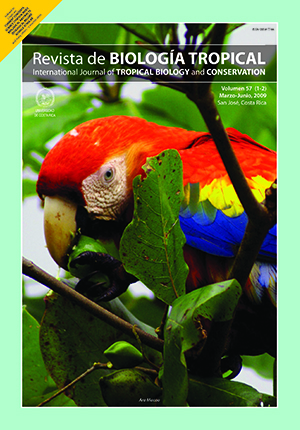Resumen
La guacamaya roja (Ara macao) es una especie en peligro de extinción. En Costa Rica, la guacamaya roja población ción del Área de Conservación Pacífico Central (ACOPAC, n = 432 personas) ha sido objeto de considerable estudio y se ha utilizado eficazmente como una especie bandera para la conservación regional. Único viable de Costa Rica Población de guacamaya roja, que se encuentra en el Área de Conservación Osa Peninsula (ACOSA, n = 800 a 1200 individuos), permanece prácticamente sin estudiar. Estudiamos ACOSA Scarlet Macaw cavidades de anidamiento de febrero 19 a marzo 22 2006. A través de entrevistas informales con los guardaparques y los residentes, se encontró un total de 57 posibles nidos en 52 árboles. Se registraron once nidos como saqueados con frecuencia. Guacamayas usado 14 especies de árboles identificados, diez de que no están registradas en Costa Rica. Los árboles de anidación más comunes fueron Caryocar costaricense (n = 12, 24%), Schizolobium parahyba (n = 9, 18,0%), Ceiba pentandra (n = 7, 14,0%) y Ficus sp. (n = 5, 10,0%). Comparamos características de anidación a las registradas en ACOPAC. Una combinación de estrategias de abajo hacia arriba y de arriba hacia abajo son necesaria para garantizar el éxito a largo plazo de la guacamaya roja, incluida la educación ambiental en las escuelas locales, administración comunitaria de los nidos activos, y el anuncio de sanciones más estrictas para la caza furtiva.##plugins.facebook.comentarios##

Esta obra está bajo una licencia internacional Creative Commons Atribución 4.0.
Derechos de autor 2009 Revista de Biología Tropical
Descargas
Los datos de descargas todavía no están disponibles.






